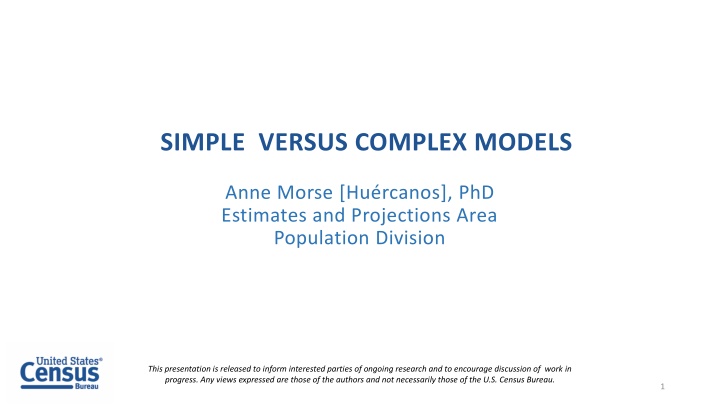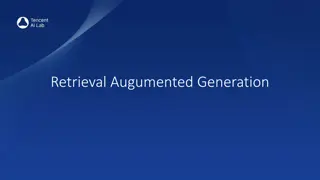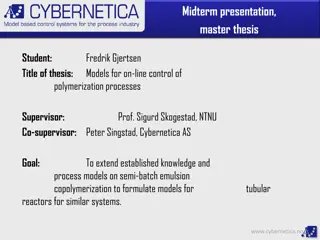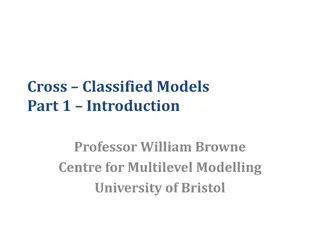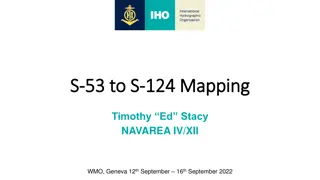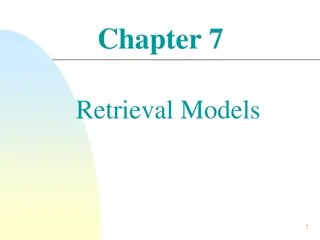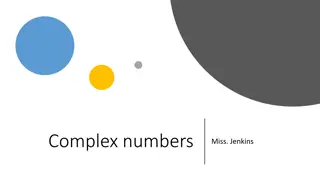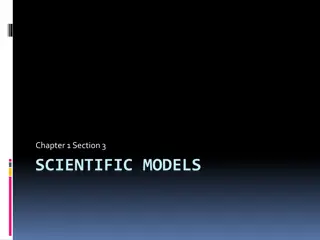SIMPLE VERSUS COMPLEX MODELS
In this presentation by Anne Morse [Hurcanos], PhD, the debate between simple and complex models in population projections is discussed. The focus is on factors beyond accuracy, such as internal consistency, use of recent data, relevant variables, development cost, and ease of explanation. The discussion highlights the potential superiority of simplicity and the importance of considering other aspects besides accuracy in forecasting models. Various sources and insights are shared, shedding light on the ongoing research in this field.
Uploaded on Feb 16, 2025 | 7 Views
Download Presentation

Please find below an Image/Link to download the presentation.
The content on the website is provided AS IS for your information and personal use only. It may not be sold, licensed, or shared on other websites without obtaining consent from the author.If you encounter any issues during the download, it is possible that the publisher has removed the file from their server.
You are allowed to download the files provided on this website for personal or commercial use, subject to the condition that they are used lawfully. All files are the property of their respective owners.
The content on the website is provided AS IS for your information and personal use only. It may not be sold, licensed, or shared on other websites without obtaining consent from the author.
E N D
Presentation Transcript
SIMPLE VERSUS COMPLEX MODELS Anne Morse [Hu rcanos], PhD Estimates and Projections Area Population Division This presentation is released to inform interested parties of ongoing research and to encourage discussion of work in progress. Any views expressed are those of the authors and not necessarily those of the U.S. Census Bureau. 1
Outline Considerations other than accuracy Theoretical reasons for the [possible] superiority of simplicity The nature of the future/time-span Decomposition/causal models Overfitting/mistaking noise for signal 2
Considerations other than accuracy Internal consistency Use of most recent data Consideration of relevant variables Cost of development Ease of explanation Usefulness for policymaking Source: Smith, Stanley K. "Further thoughts on simplicity and complexity in population projection models." International Journal of Forecasting 13.4 (1997): 557-565. 3
Considerations other than accuracy (cont.) Journals favor complexity Clients may be reassured by incomprehensibility Sources: Smith, Stanley K. "Further thoughts on simplicity and complexity in population projection models." International journal of forecasting 13.4 (1997): 557-565. Green, Kesten C., and J. Scott Armstrong. "Simple versus complex forecasting: The evidence." Journal of Business Research 68.8 (2015): 1678-1685. 4
1. The reality is simple Simple models: No-change models Linear extrapolation models No-change models may be hard to beat Knowledge is insufficient The situation is stable Sources: Green, Kesten C., and J. Scott Armstrong. "Simple versus complex forecasting: The evidence." Journal of Business Research 68.8 (2015): 1678-1685. Pant, P. Narayan, and William H. Starbuck. "Innocents in the forest: Forecasting and research methods." Journal of Management 16.2 (1990): 433-460. Rogers, Andrei. "Population forecasting: Do simple models outperform complex models?." Mathematical Population Studies 5.3 (1995): 187-202. 5
1. The reality is simple (cont.) Why might no-change or linear extrapolation models produce more accurate results than complex models? The reality (especially in the short run) is often simple Time series are highly autocorrelated More recent data are typically more relevant Use exponential smoothing Sources: Green, Kesten C., and J. Scott Armstrong. "Simple versus complex forecasting: The evidence." Journal of Business Research 68.8 (2015): 1678-1685. Pant, P. Narayan, and William H. Starbuck. "Innocents in the forest: Forecasting and research methods." Journal of Management 16.2 (1990): 433-460. Rogers, Andrei. "Population forecasting: Do simple models outperform complex models?." Mathematical Population Studies 5.3 (1995): 187-202. 6
2. Decomposition and causal models Simple models: directly project the variable of interest Complex models: Decompose the variable into parts Project using a casual variable or 7
2. Decomposition and causal models (cont.) Why might decomposing or using a causal model produce less accurate results? Basic causal factors may act more directly on the total than on the parts Source: O'neill, Brian C., et al. "A guide to global population projections." Demographic Research 4 (2001): 203-288. 8
2. Decomposition and causal models (cont.) Why might decomposing or using a causal model produce less accurate results? The data may be worse Of the causal variable Of the decomposed components The data may be Short Noisy Non-representative Source: O'neill, Brian C., et al. "A guide to global population projections." Demographic Research 4 (2001): 203-288. 9
2. Decomposition and causal models (cont.) Sources: Vaupel, James W., and Anatoli I. Yashin. "Heterogeneity's ruses: some surprising effects of selection on population dynamics." The American Statistician 39.3 (1985): 176-185. 10
2. Decomposition and causal models (cont.) Future (t+5) Current (t) Why might decomposing or using a causal model produce less accurate results? 0-4 0-4 5-9 5-9 Input variables may be harder to project than the output variable 10-14 10-14 25-29 85+ 11 Source: O'neill, Brian C., et al. "A guide to global population projections." Demographic Research 4 (2001): 203-288.
2. Decomposition and causal models (cont.) Why might we decompose even if the input variable is harder to project than the output variable? Stakeholder needs Source: O'neill, Brian C., et al. "A guide to global population projections." Demographic Research 4 (2001): 203-288. 12
2. Decomposition and causal models (cont.) We expect the cohort-component method to be more accurate than a simple method when the trends of the input variables are relatively stable We expect the cohort-component method to be less accurate than a simple method when there is a major turning point in the input trend This makes the piece more difficult to predict than the whole Source: O'neill, Brian C., et al. "A guide to global population projections." Demographic Research 4 (2001): 203-288. 13
2. Decomposition and causal models (cont.) Projection with a simple (average rate) model We expect the cohort- component method to be less accurate than a simple method when there is a major turning point in the input trend Sources: Historical Population Change Data (1910-2020), U.S. Census Bureau Pant, P. Narayan, and William H. Starbuck. "Innocents in the forest: Forecasting and research methods." Journal of Management 16.2 (1990): 433-460. Rogers, Andrei. "Population forecasting: Do simple models outperform complex models?." Mathematical Population Studies 5.3 (1995): 187-202. 14
2. Decomposition and causal models (cont.) Projection with a complex (cohort-component) model We expect the cohort- component method to be less accurate than a simple method when there is a major turning point in the input trend Sources: Historical Population Change Data (1910-2020), U.S. Census Bureau Zitter, Meyer and Siegel Jacob. Illustrative Projections of the Population of the United States by Age and Sex 1960 to 1980. Current Population Reports. 25.187 (1958) 15
2. Decomposition and causal models (cont.) Projection with a complex (cohort-component) model We expect the cohort- component method to be less accurate than a simple method when there is a major turning point in the input trend Sources: Hamilton BE, Lu L, Chong Y, et al. Natality trends in the United States, 1909 2018. National Center for Health Statistics. 2020. Zitter, Meyer and Siegel Jacob. Illustrative Projections of the Population of the United States by Age and Sex 1960 to 1980. Current Population Reports. 25.187 (1958) 16
2. Decomposition and causal models (cont.) Why might using a causal model produce less accurate results? A weak causal relationship Source: Vigen, Tyler. Spurious correlations. Hachette UK, 2015. https://tylervigen.com/spurious-correlations 17
2. Decomposition and causal models (cont.) Decomposition is most useful when: There is valid and reliable information about each element Elements are subject to different causal forces Elements are easier to predict than the whole Sources: Green, Kesten C., and J. Scott Armstrong. "Simple versus complex forecasting: The evidence." Journal of Business Research 68.8 (2015): 1678-1685. 18
3. Overfitting Complex forecasting methods mistake random noise for information The key is in determining whether the patterns represent noise or signal Need for theory! Predictions may be more prone to failure in the era of Big data Sources: Silver, Nate. The signal and the noise: Why so many predictions fail-but some don't. Penguin, 2012. 19
3. Overfitting (cont.) Overfitting occurs when the model is fit so closely to the training data that it loses its generalizability More likely to overfit when: Data are noisy Poor understanding of fundamental relationships Sources: Silver, Nate. The signal and the noise: Why so many predictions fail-but some don't. Penguin, 2012. 20
3. Overfitting (cont.) More likely to overfit when: Data are noisy Make data less noisy Smooth and de-seasonalize! Sources: Makridakis, Spyros, Evangelos Spiliotis, and Vassilios Assimakopoulos. "Statistical and Machine Learning forecasting methods: Concerns and ways forward." PloS one 13.3 (2018): Pant, P. Narayan, and William H. Starbuck. "Innocents in the forest: Forecasting and research methods." Journal of Management 16.2 (1990): 433-460. Mirzavand, Mohammad, and Reza Ghazavi. "A stochastic modelling technique for groundwater level forecasting in an arid environment using time series methods." Water Resources Management 29.4 (2015): 1315-1328. 21
3. Overfitting (cont.) There is no reason for such complex methods to be less accurate than simple statistical benchmarks, at least once their shortcoming of over-fitting is corrected. Sources: Makridakis, Spyros, Evangelos Spiliotis, and Vassilios Assimakopoulos. "The M4 Competition: 100,000 time series and 61 forecasting methods." International Journal of Forecasting 36.1 (2020): 54-74. 22
3. Overfitting (cont.) Men may construe things after their fashion/ Clean from the purpose of the things themselves. Shakespeare s Cicero Sources: Makridakis, Spyros, Evangelos Spiliotis, and Vassilios Assimakopoulos. "The M4 Competition: 100,000 time series and 61 forecasting methods." International Journal of Forecasting 36.1 (2020): 54-74. 23
Conclusion Consciously articulate all considerations that influence your choices Carefully consider when to include a causal model or when to decompose Is the causal theory strong? Are the data usable? Is the element easy to predict? 24
Conclusion Consciously articulate all considerations that influence your choices Carefully consider when to include a causal model or when to decompose Get rid of unnecessary noise in your data: Smooth and deseasonalized! Don t overfit your data 25
Thank you! Anne Morse [Hu rcanos] anne.morse@census.gov Estimates and Projections Area Population Division U.S. Census Bureau 26
